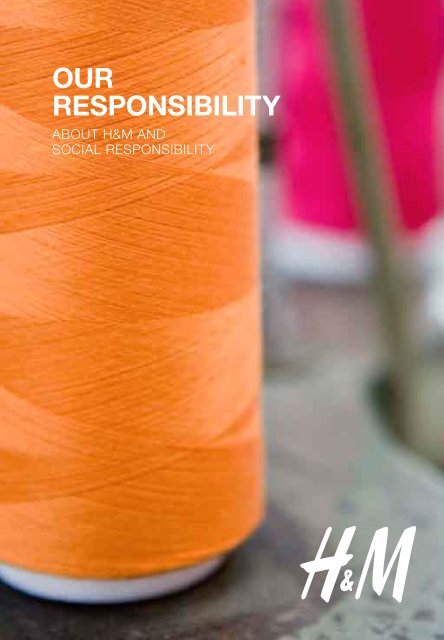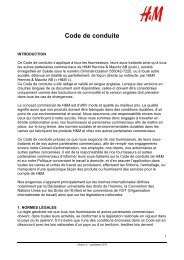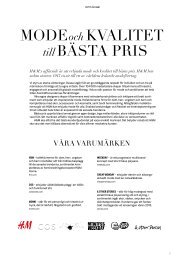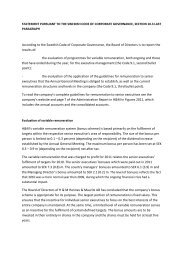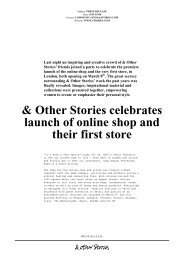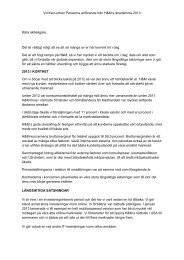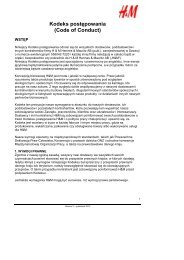Our respOnsibility - H&M.com
Our respOnsibility - H&M.com
Our respOnsibility - H&M.com
You also want an ePaper? Increase the reach of your titles
YUMPU automatically turns print PDFs into web optimized ePapers that Google loves.
<strong>Our</strong><br />
responsibility<br />
About H&M and<br />
social responsibility
<strong>Our</strong> responsibility<br />
H&M’s business concept is to offer our customers fashion and quality<br />
at the best price. At H&M, quality is about more than making sure that<br />
our products meet or exceed our customers’ expectations. It also<br />
means that they have to be manufactured under good conditions and<br />
that our customers must be satisfied with us as a <strong>com</strong>pany. Taking<br />
responsibility for how our operations affect people and the environment<br />
is also an essential prerequisite for H&M’s continued profitability and<br />
growth. Here we explain how we do this.
Contents<br />
PAGE 6<br />
Follow Tobias Fischer and Payal Jain, two of around 40 H&M<br />
auditors, during a typical working day in New Delhi.<br />
PAGE 8<br />
The code of conduct is an agreement that all H&M’s<br />
suppliers have to <strong>com</strong>ply with. It sets out the <strong>com</strong>pany’s requirements<br />
concerning aspects such as good working conditions.<br />
PAGE 12<br />
MeeT MUHAMMED AKHTARUZZAMAN, factory manager in Dhaka,<br />
Bangladesh. He tells us all about working with H&M and what<br />
effect this has had on his factory.<br />
PAGE 14<br />
Rokeya Rafique and Shirin Akter are two representatives of<br />
the Karmojibi Nari organisation in Bangladesh. Read about what<br />
they think of the co-operation with H&M.<br />
PAGE 16<br />
H&M’s world: this shows where our goods are produced and<br />
where they are sold, and what development projects we support.<br />
PAGE 20<br />
H&M’s code of conduct suppliers to <strong>com</strong>ply with the<br />
environmental legislation applicable in their own country. We<br />
also encourage them to take more environmental responsibility<br />
than the law requires.<br />
A shared<br />
responsibility<br />
During a recent trip to Asia I had the<br />
opportunity to visit several of our suppliers,<br />
including some in China. I also met some of<br />
H&M’s auditors, whose job it is to monitor<br />
<strong>com</strong>pliance with our code of conduct, and<br />
gained an insight into the extensive work that<br />
goes into improving the working conditions in<br />
our suppliers’ factories. It was reassuring to<br />
see for myself how effectively this part of our<br />
organisation functions.<br />
I am in no doubt that long-term profitability<br />
and good relations with our customers and<br />
other stakeholders depends upon us taking<br />
responsibility for how people and the<br />
environment are affected by what we do. We<br />
are continually receiving input from the world<br />
around us, not least from customers and<br />
employees, indicating that the environment<br />
and social responsibility are issues that<br />
engage people.<br />
H&M has signed up to the UN’s Global<br />
Compact and supports its ten principles. We<br />
want to send out the message that we are<br />
prepared to act in accordance with Kofi<br />
Annan’s appeal to <strong>com</strong>panies to respect<br />
human rights and to contribute to sustainable<br />
development within the areas we can affect.<br />
H&M also supports the OECD guidelines for<br />
multinational enterprises and is a member<br />
of the Amnesty Business Group.<br />
The CSR department* reports directly to me,<br />
so I have been able to follow this important<br />
work closely. This means I can assure H&M’s<br />
customers, staff, shareholders and other<br />
stakeholders that we are devoting our<br />
expertise and our <strong>com</strong>mitment to pressing<br />
ahead with this work. We have already made<br />
good progress, but to be successful in our<br />
quest for a better society we also have to<br />
continue working closely in partnership with<br />
others.<br />
Rolf Eriksen, CEO, H&M<br />
“ It is important for<br />
us to accept our<br />
responsibility and<br />
to press ahead<br />
with this work.”<br />
ROLF ERIKSEN<br />
DANISH<br />
STOCKHOLM, SWEDEN<br />
WIFE AND TWO CHILDREN<br />
CEO, H&M<br />
* CSR stands for corporate social responsibility, and means that the <strong>com</strong>pany voluntarily takes account of social and<br />
environmental issues in the way it operates, to help contribute towards sustainable development.<br />
NAME<br />
NATIONALITY<br />
LIVES IN<br />
FAMILY<br />
PROFESSION
Did you know that... Around 750 people work at H&M’s offices in the<br />
manufacturing countries. Most of them are locals.<br />
<br />
A day in the life of an auditor<br />
Payal Jain and Tobias Fischer are two of around 40 auditors<br />
working for H&M. Their job is to inspect working conditions at<br />
H&M’s suppliers and to check that the ILO core conventions and<br />
H&M’s Code of Conduct are being respected. Payal and Tobias<br />
work together, visiting suppliers in and around New Delhi.<br />
Outside New Delhi. It is early in the morning<br />
when Tobias Fischer and Payal Jain arrive at<br />
the factory gates in their car. No one knows<br />
they are <strong>com</strong>ing today. Tobias and Payal wear<br />
H&M ID badges so that the guards and the<br />
factory staff know who they are. Six months<br />
ago, auditors carried out a <strong>com</strong>prehensive<br />
inspection of the working conditions at the<br />
factory and Payal and Tobias are here today<br />
to find out whether the supplier has achieved<br />
the short-term goals set during that visit.<br />
“ We want the suppliers to<br />
strive for lasting improvements<br />
because they can see the<br />
benefits for themselves.”<br />
Code of conduct is the starting point<br />
Like all of H&M’s suppliers, the factory has<br />
signed up to a cooperation agreement –<br />
H&M’s Code of Conduct – promising to <strong>com</strong>ply<br />
with local legislation and H&M’s requirements<br />
regarding the working environment. The<br />
agreement also contains a provision stipulating<br />
that H&M’s auditors can make unannounced<br />
visits.<br />
“We carry out an extensive audit whenever<br />
we start working with a new supplier. This<br />
takes between two and seven days. We work<br />
with the factory managers to identify key areas<br />
for improvement, and decide on a plan of<br />
action. The plan contains both long-term and<br />
short-term goals and sets out how the goals<br />
should be achieved, who will be responsible<br />
and when the work should be <strong>com</strong>pleted,”<br />
explains Tobias.<br />
Unannounced visits<br />
Payal and Tobias enter the factory and ask for<br />
the manager. He greets them and ac<strong>com</strong>panies<br />
them on a tour of the factory. Since H&M first<br />
introduced the code of conduct in India in<br />
1998, the auditors have made repeated visits<br />
to the factories.<br />
“To begin with the factory owners were a<br />
little unused to the idea of being inspected like<br />
this. Now they understand that unannounced<br />
visits are part and parcel of the way we work,<br />
and few are surprised when we turn up out of<br />
the blue,” says Payal.<br />
Improvements implemented<br />
The auditors check the fire escapes and<br />
discuss safety routines with a factory<br />
representative. These include the provision<br />
of fire alarms, emergency exits and fire<br />
extinguishers, but also cover aspects such as<br />
making sure the factory is always clean and<br />
tidy and that there are a sufficient number of<br />
good, clean toilets. The working environment<br />
is important, both for the workers’ wellbeing<br />
and for the quality of the clothing produced.<br />
Payal notes that the working environment has<br />
improved considerably since the last visit.<br />
In the past there had been problems with<br />
material remnants from the cutting machines<br />
and thread from the production area being left<br />
lying around. Now the factory has employed<br />
more cleaners, supplied suitable tools and<br />
equipment and introduced better routines.<br />
The factory is clean and is now a safer and<br />
more pleasant place for the employees to<br />
work.<br />
Overtime a problem<br />
When Payal and Tobias have finished the<br />
factory inspection they go to the supplier’s<br />
office to examine the paperwork relating to the<br />
employees. They check payroll information<br />
and employee records, and see how much<br />
overtime has been worked. Recently, some<br />
departments at the factory were understaffed.<br />
This hampered production and led to<br />
excessive amounts of overtime being worked.<br />
Having inspected the time cards, payroll<br />
information and production records, Tobias<br />
and Payal can confirm that the overtime has<br />
been reduced, but it is still above the legal<br />
limit. The supplier will have to continue<br />
following the action plan.<br />
Then it’s time to drive back to H&M’s offices<br />
in New Delhi to document the visit and to<br />
report back to the CSR department at head<br />
office in Sweden.<br />
Influencing attitudes<br />
The auditor’s job is far from simple because<br />
it involves influencing other people’s attitudes<br />
and behaviour. Payal explains:<br />
“It can be quite a tough challenge to persuade<br />
suppliers that they have a lot to gain from<br />
H&M’s Code of Conduct and the cooperation<br />
with us. I try and get them to see that it can<br />
make their employees more motivated and may<br />
well even increase productivity. We want the<br />
suppliers to strive for lasting improvements<br />
because they can see the benefits for themselves,<br />
not just because the buyer says they<br />
have to. Their task, as I see it, is to put us out<br />
of a job.<br />
Tobias Fischer and Payal Jain are two of around 40<br />
employees who check that suppliers are <strong>com</strong>plying<br />
with H&M’s Code of Conduct.
Did you know that... H&M signed up to the UN Global Compact in 2001.<br />
<br />
<strong>Our</strong> code of conduct<br />
– a long-term <strong>com</strong>mitment<br />
We are all dependent upon sustainable development. Polluting water<br />
and spoiling other natural resources is not sustainable, nor is violating<br />
human rights. That’s why more and more <strong>com</strong>panies are drawing up<br />
special regulations, so-called codes of conduct, for their suppliers.<br />
H&M’s code of conduct was drawn up in<br />
1997 and is based on the UN Convention on the<br />
Rights of the Child and the ILO’s conventions<br />
on working conditions and employment rights.<br />
It exists because we want our products to be<br />
manufactured under good working conditions.<br />
A code of conduct must be more than just<br />
fine words; it has to be rooted in reality.<br />
Factories that don’t meet the requirements of<br />
H&M’s Code of Conduct receive assistance to<br />
help them improve and to develop. That’s why<br />
we have around 40 auditors working full time,<br />
checking that suppliers <strong>com</strong>ply with our code<br />
and giving the factories advice and assistance.<br />
The aim is to get them to see for themselves the<br />
long-term benefits that improved conditions<br />
can bring. H&M also has a 150-strong team of<br />
inspectors whose job is to control the quality of<br />
the clothes. They can also report any breach of<br />
the code of conduct they may spot during their<br />
factory visits.<br />
Read more about the background to H&M’s Code of<br />
Conduct on page 10 or at www.hm.<strong>com</strong>/csr.<br />
H&M’s Code of Conduct exists because we want our<br />
products to be manufactured under good conditions.<br />
H&M’s code of conduct includes<br />
the following stipulations:<br />
Ban on child labour<br />
Fortunately, child labour is not a <strong>com</strong>mon<br />
occurrence at the factories that manufacture<br />
H&M products. If H&M were to find a child who<br />
was below the statutory minimum age working<br />
at one of our suppliers, we would work to find<br />
a solution that was in that individual’s best<br />
interests. Co-operation would end if the<br />
supplier repeatedly breached H&M’s ban on<br />
child labour.<br />
Good working environment and fire safety<br />
The factories where H&M’s clothes are made<br />
have to provide a clean and safe working<br />
environment. There must be a high level of fire<br />
safety, and regular fire drills must be held.<br />
Emergency exits must be clearly marked and<br />
must not be blocked. The lighting must work<br />
properly and all areas must be kept clean.<br />
Reasonable working hours and wages<br />
Wages must be paid regularly and should be<br />
in proportion to the work carried out. Overtime<br />
must be voluntary and properly <strong>com</strong>pensated.<br />
Female employees must have a right to<br />
maternity leave.<br />
Right to organise and ban on<br />
discrimination<br />
All employees have a right to an employment<br />
contract and the right to organise. There must<br />
not be any discrimination on the grounds of<br />
gender, religion or ethnic background.<br />
ILO conventions<br />
The International Labour Organisation (ILO) is a UN<br />
body consisting of representatives of government,<br />
employer organisations and trade unions. It works<br />
to improve working and living conditions by<br />
drawing up conventions and re<strong>com</strong>mendations<br />
concerning wages, working hours, employment<br />
conditions and social systems.<br />
Read more at www.ilo.org.<br />
UN Convention on the Rights of the Child<br />
The UN Convention on the Rights of the Child<br />
applies to children and young people throughout<br />
the world. Most countries have signed up to the<br />
Convention, whose principles state that all children<br />
are of equal worth, that all children have the right to<br />
an education, care and security and that persons or<br />
bodies who make decisions that affect children<br />
must do so based on the child’s best interests.<br />
Read more at www.unicef.org/crc.<br />
Environmental and chemical restrictions<br />
H&M requires its suppliers to take responsibility<br />
for the impact they have on the environment.<br />
This means that in addition to <strong>com</strong>plying with<br />
the legislation applicable in their own country,<br />
they also have to sign an agreement promising<br />
to <strong>com</strong>ply with H&M’s chemical restrictions.<br />
These safeguard our customers’ health and<br />
safety, as well as the environment.<br />
The full text of the code of conduct can be found at<br />
www.hm.<strong>com</strong>/csr.<br />
Talking to factory employees provides an insight into the<br />
situation at their workplaces.
10 Did you know that... H&M has carried out more than 15,000 factory inspections since 1998.<br />
11<br />
Active co-operation<br />
H&M does not accept<br />
child labour<br />
H&M does not own or operate any factories<br />
of its own. <strong>Our</strong> clothes and other products are<br />
manufactured at around 700 supplier factories,<br />
with most of the production taking place in<br />
Asia and Europe.<br />
Stipulating standards of production, both in<br />
terms of the quality of the clothes and the<br />
working environment in the factories, is nothing<br />
new for H&M. We have long held the view that<br />
as a <strong>com</strong>pany, we have a responsibility for<br />
everyone who contributes to H&M’s success.<br />
“We have learned to take one<br />
small step at a time, always<br />
making sure we’re moving<br />
in the right direction.”<br />
H&M drew up its own code of conduct in 1997<br />
to <strong>com</strong>bat substandard working conditions.<br />
Child labour was very much in the news at the<br />
time, and was a pressing issue, so we also got<br />
the Save the Children organisation involved in<br />
the drafting of the code of conduct. H&M’s own<br />
experience was also an important influence on the<br />
final shape of the document. Ingrid Schullström,<br />
who is responsible for the environment and<br />
social responsibility at H&M, was one of those<br />
who helped get the project off the ground.<br />
“More concrete effort and pro-active work was<br />
needed from H&M,” says Ingrid Schullström.<br />
“These are important issues and we want to take<br />
our responsibility. We have already <strong>com</strong>e an<br />
unbelievably long way, and work is still ongoing.<br />
We’re now at the stage where we’re focusing on<br />
more specific and <strong>com</strong>plicated issues such as<br />
trade union rights. We have learned to take one<br />
small step at a time, always making sure we’re<br />
moving in the right direction.”<br />
Textile worker in Cambodia, where H&M works with ILO’s<br />
Better Factories Cambodia.<br />
H&M takes the issue of child labour<br />
extremely seriously. The code of conduct<br />
states very clearly that child labour is not<br />
permitted in the suppliers’ factories.<br />
If any of H&M’s auditors discovers a person<br />
who is still below the statutory minimum age<br />
for work, we try and find the best possible<br />
solution in consultation with the supplier and<br />
the child’s family. We take account of the<br />
child’s age, level of education and conditions<br />
at home. The solution often involves some<br />
form of education. It is very important that any<br />
change leads to an improvement in the<br />
situation of the individual person. If the child is<br />
just forced out of the factory without any<br />
follow-up, there is unfortunately a risk that he<br />
or she may end up doing other, heavier work.<br />
But if H&M discovers repeated breaches of<br />
its ban on child labour at the same supplier or<br />
one of its subsuppliers, the cooperation will be<br />
ended for good.<br />
How do we make sure there<br />
is no child labour?<br />
When inspecting the factories, H&M’s auditors<br />
keep an eye out for any workers who look too<br />
Training is an effective way of preventing child labour.<br />
young. It is also the job of the auditors to check<br />
employment papers and other documentation<br />
concerning the employees. Any gaps in the<br />
paperwork might indicate there is a problem.<br />
The auditors can then provide advice on how<br />
the employer can organise the hiring of new<br />
staff to make sure no underage employees are<br />
taken on, such as requiring a birth certificate.<br />
What is the age limit?<br />
H&M’s child labour policy is based on the UN<br />
Convention on the Rights of the Child and ILO<br />
convention 138, but also on the national<br />
legislation of the country concerned. The basic<br />
rule is that no one under the age of 15 should<br />
be employed at the suppliers’ factories.<br />
A better situation for children<br />
We are aware of the vulnerable situation of<br />
children in many parts of the world. That’s why<br />
we work actively both with our suppliers and<br />
with local organisations to improve children’s<br />
future prospects. We support UNICEF’s work<br />
with girls’ education.<br />
Read more about UNICEF on page 19.
Did you know that... H&M is the largest European buyer of clothes from Bangladesh.<br />
13<br />
A factory manager reports<br />
A large number of H&M garments are produced at the factory<br />
FCI (Fashion Club International) in Dhaka, one of the better<br />
factories in terms of <strong>com</strong>pliance with H&M’s Code of Conduct.<br />
Chief operating officer Muhammed Akhtaruzzaman’s philosophy<br />
is to maintain a family atmosphere in the factory and involve the<br />
workers in the <strong>com</strong>pany and its development.<br />
“When the workers are part of the result and<br />
get something out of it, they are motivated and<br />
feel a sense of responsibility,” Muhammed<br />
Akhtaruzzaman explains.<br />
According to his philosophy, the workers at<br />
FCI take part of the profit through additional<br />
performance bonuses and attendance bonuses.<br />
There is a policy for equal opportunity and<br />
equal treatment and all sewing operators have<br />
a chance to advance.<br />
“We have 60 to 70 supervisors who were all<br />
promoted from the floor. 90 per cent of the<br />
office staff also started their career on the<br />
factory floor.”<br />
”Human resources play<br />
a vital role in building up<br />
a successful industry.”<br />
Focus on the working environment<br />
Almost 1,400 people work in the one-storey<br />
building where FCI operates. A great deal of<br />
effort has gone into creating the interior<br />
environment. The sewing area is light and<br />
clean, and an air-conditioning system keeps<br />
the air cool. FCI provides the employees with<br />
free transportation, group and life insurance,<br />
75 per cent subsidized lunches and free<br />
snacks. There are two separate praying areas<br />
in the factory, as well as medical and childcare<br />
facilities. And, in addition, a welfare fund has<br />
been formed in order to support workers<br />
financially when there is a special need.<br />
“I believe the fund is quite unique,” says<br />
Muhammed Akhtaruzzaman, who used to be<br />
a legal advisor before he became garment<br />
factory manager.<br />
He explains that generally in Bangladesh,<br />
garment workers are not organised, or they do<br />
not benefit much from the trade unions. At FCI,<br />
the workers’ representation welfare <strong>com</strong>mittee<br />
(WRWC) is the workers’ voice. Once a month<br />
the WRWC meets with the management to<br />
exchange views and bring up issues.<br />
Workers’ <strong>com</strong>mittees<br />
“<strong>Our</strong> workers’ welfare <strong>com</strong>mittee was initially<br />
formed at the request of H&M. They gave us<br />
ideas about how to act and how to identify<br />
code of conduct issues,” says Muhammed<br />
Akhtaruzzaman. “I believe that everyone<br />
should have a code of conduct and follow it<br />
rigorously. It benefits not only the workers but<br />
the production and the quality as well. Human<br />
resources play a vital role in building up a<br />
successful industry”.<br />
Despite numerous good practices, FCI<br />
still has a few issues to sort out. Excessive<br />
overtime is one of them. H&M’s audits have<br />
shown that some of the workers have worked<br />
long hours and for too long without days off.<br />
The factory is to address these issues, and the<br />
progress will be followed up by H&M.<br />
Muhammed Akhtaruzzaman runs FCI in Dhaka in<br />
Bangladesh.
14<br />
Did you know that... H&M has been dealing with Bangladeshi suppliers for more than 20 years.<br />
“ The most important thing is<br />
the change of attitudes”<br />
“The garment sector has brought a silent<br />
revolution for women in our society,” claims<br />
Shirin Akter, a labour rights activist since 1970<br />
in Bangladesh. She is a strong and well-known<br />
voice for garment workers and president of the<br />
women’s rights organisation Karmojibi Nari<br />
(KN), meaning “working woman”. In August<br />
2004, H&M and KN started a project with the<br />
objective of increasing awareness among<br />
garment workers of their rights. A training<br />
programme was developed primarily for female<br />
workers, focusing on gender equality and<br />
workers’ relations with management in factories<br />
producing for H&M.<br />
“<strong>Our</strong> society is a patriarchy and the trade<br />
unions are male dominated. Women have<br />
always believed that it is a man’s job to speak<br />
out. The female workers have little knowledge<br />
of labour laws,” Shirin Akter explains.<br />
Seeing things in a new light<br />
Rokeya Rafique, a famous actress in Bangladesh,<br />
is doing the training.<br />
“Each and every session is an eye-opener<br />
for the participants,” Rokeya says. “The most<br />
important thing is the change of attitudes.<br />
After the training, women know there are laws<br />
for maternity leave, equal pay for equal work<br />
and overtime. They be<strong>com</strong>e brave. They feel<br />
equal, they can talk to the management or a<br />
colleague about their problems.”<br />
The training groups consist of randomly<br />
selected participants at a number of factories.<br />
The groups are 20 per cent male and 80 per<br />
cent female workers – the same proportions as<br />
in the garment sector in Bangladesh. Leaflets<br />
are circulated at the factories and each<br />
participant has the task of sharing the new<br />
knowledge with five colleagues. Welfare<br />
officers have also been trained by KN. Their<br />
task is to educate employees and middle<br />
management in workers’ rights, with the aim<br />
of improving relations between workers and<br />
management.<br />
” <strong>Our</strong> society is a patriarchy<br />
and the trade unions are<br />
male dominated.”<br />
Still plenty to do<br />
The contradiction of manufacturing <strong>com</strong>panies<br />
which operate in poor, developing countries<br />
implementing codes of conduct but squeezing<br />
costs at the same time is not lost on Shirin<br />
Akter. But she is convinced this kind of<br />
cooperation will benefit both sides.<br />
“If it is not only cosmetic but really for the<br />
benefit of the workers and business, then we<br />
have many things to do. H&M’s programme is<br />
integrated and long term. We are very pleased<br />
and proud of our co-operation and of the fact<br />
that H&M is concerned about workers’ rights,”<br />
concludes Shirin Akter.<br />
Rokeya Rafique and Shirin Akter campaign for<br />
workers’ rights in Bangladesh.
16<br />
17<br />
Global responsibility<br />
H&M’s world is growing year by year. As we expand, our<br />
area of responsibility also grows wider. The map shows<br />
where we sell our products and where our products are made.<br />
Cooperation and partnership<br />
UN Global Compact<br />
H&M supports the ten principles of the Global<br />
Compact on human rights, working conditions,<br />
environment and anti-corruption. Global<br />
Compact is a co-operation between the UN<br />
and industry. H&M also supports the OECD’s<br />
guidelines for multinational enterprises.<br />
Read more about Global Compact at<br />
www.unglobal<strong>com</strong>pact.org and about the OECD<br />
guidelines at www.oecd.org.<br />
The UN’s Millennium Development Goals<br />
H&M contributes to the Millennium Development<br />
Goals through its active environmental work<br />
with suppliers, including key measures such as<br />
chemicals restrictions and water treatment.<br />
The Millennium Goals are eight clear goals<br />
for global development, all with target dates.<br />
They are described in the UN Millennium<br />
Declaration which was signed by the world’s<br />
leaders during the so-called Millennium<br />
Summit in New York in 2000. Today the<br />
Millennium Development Goals are at the heart<br />
of most of the development work around the<br />
world. The goals cover areas such as fighting<br />
poverty and hunger, reducing child mortality,<br />
improving maternal health, environmental<br />
sustainability, ending gender discrimination<br />
and eradicating HIV/AIDS, malaria and other<br />
diseases.<br />
We also contribute to charity projects such<br />
as those aimed at giving people access to clean<br />
water, and giving children access to education<br />
in various parts of the world. But as a buyer of<br />
clothes in many developing countries, possibly<br />
the greatest contribution we make towards<br />
fightin g poverty is creating employment for<br />
hundreds of thousands of factory workers.<br />
Read more about the Millennium Development Goals<br />
at www.un.org/millenniumgoals.<br />
Amnesty Business Group<br />
H&M is a member of the Business Forum, part<br />
of the Amnesty Business Group. This is a<br />
group of Swedish <strong>com</strong>panies which operate<br />
internationally and which are active in the area<br />
of promoting human rights. ABG is part of the<br />
Swedish section of Amnesty International, and<br />
its mission is to teach Swedish <strong>com</strong>panies to<br />
respect, defend and promote human rights<br />
wherever they operate.<br />
As a member of the Business Forum, H&M<br />
has access to Amnesty’s knowledge network<br />
and can share experience with other international<br />
member <strong>com</strong>panies on a range of issues, from<br />
a country risk analysis to human rights training.<br />
Read more about ABG at www.amnesty.se/business.<br />
WaterAid<br />
H&M supports the work of the British aid<br />
organisation WaterAid, to improve access to<br />
and quality of water for people in Asia and<br />
Africa. For more than a billion people, getting<br />
water is a daily struggle. Women in these parts<br />
of the world can walk up to six hours a day to<br />
fetch water. H&M has been contributing to<br />
WaterAid’s work since 2002, by donating part<br />
of the revenue from selected swimwear.<br />
Read more about WaterAid at www.wateraid.org.<br />
H&M keeps its prices<br />
<strong>com</strong>petitive by:<br />
having few middlemen<br />
buying large volumes<br />
having an efficient distribution system<br />
being cost-conscious at every stage<br />
Fair Labor Association<br />
H&M has been involved in the Fair Labor<br />
Association (FLA) since 2006. FLA is an<br />
organisation that safeguards workers’ rights<br />
and seeks to improve their working conditions.<br />
FLA carries out independent checks on<br />
member <strong>com</strong>panies’ suppliers and publishes<br />
the results annually on its website. For H&M,<br />
this means another layer of quality assurance<br />
in our own system for monitoring our suppliers’<br />
factories.<br />
Read more about FLA at www.fairlabor.org.<br />
sales market<br />
production offices<br />
Clothes for charity<br />
Disasters such as war and earthquake affect<br />
people all over the world. Victims need aid,<br />
including clothing. H&M works with recognised<br />
aid organisations in every one of our sales<br />
countries. We donate clothes which, for<br />
various reasons, have failed to meet H&M’s<br />
quality standards and have therefore been<br />
rejected. Obviously we do not donate clothes<br />
that fail to meet our safety standards.
18 Did you know that... More than 500 young people have received training since<br />
19<br />
H&M opened its sewing school in Bangladesh in 1999.<br />
<strong>Our</strong> contribution to<br />
social development<br />
An important part of H&M’s responsibility is to contribute to local<br />
development in countries where our projects are manufactured<br />
or sold. It is also important that we can be involved in the various<br />
projects and make sure that they are developing in the right<br />
direction, and are sustainable in the long term.<br />
H&M invests in young people in Bangladesh<br />
Many young people in Bangladesh dream<br />
about getting a job in a garment factory. But<br />
many of them lack vocational education and<br />
can only perform simple and monotonous<br />
tasks at the factories. In 1999, H&M started a<br />
training course in sewing for young people in<br />
Dhaka, the capital. This has now grown into<br />
two training centres where a total of 100 young<br />
people a year receive vocational training in<br />
sewing after finishing their basic education.<br />
H&M pays wages during the training period,<br />
and once students have <strong>com</strong>pleted their training<br />
they are guaranteed a job as a machinist at one<br />
of H&M’s suppliers.<br />
“ I have had opportunities<br />
that otherwise might not<br />
be possible.”<br />
Mohammad Ashraful is 20 years old and <strong>com</strong>es<br />
from Kushtia in western Bangladesh. He lives in<br />
Dhaka with his parents and four brothers and<br />
sisters. Mohammad came to H&M’s training<br />
centre via the organisation BRAC. He says he<br />
enjoyed the training: instead of just learning<br />
about an individual aspect of the job, he now<br />
understands the whole manufacturing process.<br />
He has also learned about issues such as health<br />
and safety in the workplace. Mohammed believes<br />
that the training has given him opportunities he<br />
would not otherwise have had. After <strong>com</strong>pleting<br />
the course he got a job at one of the factories<br />
H&M buys from. He is currently undergoing<br />
in-house training at the factory to be<strong>com</strong>e a<br />
supervisor, and dreams of being a factory<br />
manager one day.<br />
H&M trains young people in sewing in Dhaka.<br />
H&M helps to raise factory workers’ awareness of<br />
HIV/Aids and health.<br />
UNICEF’s education for girls<br />
More than 120 million children all over the<br />
world are denied the opportunity to go to<br />
school, and the majority of them are girls.<br />
This violates the convention on the rights of<br />
the child, which states that all children have<br />
the same human rights including the right to a<br />
free basic education. The international “25 by<br />
2005” campaign, which is supported by H&M,<br />
aims to accelerate the development of girls’<br />
education. One aspect of the work is aimed<br />
at changing attitudes among authorities and<br />
parents, to show them the benefits of<br />
allowing girls to go to school. Another is to<br />
make education more practically accessible.<br />
The mobile school is one concept being<br />
pursued by UNICEF, bringing classrooms to<br />
places which traditional education cannot<br />
normally reach. UNICEF also trains female<br />
teachers and provides special grants for girls.<br />
Read more on page 22.<br />
Preventing the spread of HIV/Aids<br />
in Cambodia<br />
Cambodia has the fastest-growing rate of HIV/<br />
Aids in south-east Asia. It is also a country<br />
where H&M’s clothes are made, so it seems<br />
only right that we should help to try and<br />
prevent the spread of HIV/Aids there. This is<br />
another project where H&M works in<br />
partnership with UNICEF.<br />
Around 290,000 people work in some 200<br />
garment factories in Cambodia. The majority<br />
of them are young women, a risk group that<br />
UNICEF is making special efforts to reach.<br />
H&M plays a key role here by encouraging the<br />
factories to allow their employees to take part<br />
in the preventative activities organised by<br />
UNICEF during working hours. The aim is to<br />
increase female factory workers’ awareness of<br />
HIV/Aids and knowledge of other health<br />
issues, to help them improve their healthcare<br />
and to make it easier for them to make<br />
informed choices.<br />
Other resources have also been devoted to<br />
the project. For example, a helpline has been<br />
set up where anyone can ring and ask<br />
questions about HIV/Aids. H&M is one of the<br />
<strong>com</strong>panies providing the funding for this. The<br />
number of enquiries has risen recently, and the<br />
line is now open six days a week.
Did you know that... H&M’s chemicals requirements are based on the sales country which has the strictest standards. 21<br />
Environmental responsibility<br />
Just as H&M takes responsibility for the working conditions in the<br />
suppliers’ factories, we also accept responsibility for how our products<br />
affect the local environment in the manufacturing countries.<br />
Clean air, fresh water and unspoiled nature can<br />
no longer be taken for granted anywhere in the<br />
world. People and <strong>com</strong>panies have to shoulder<br />
responsibility for ensuring that development is<br />
sustainable. For H&M, this means minimising<br />
our impact on the environment. It also means<br />
that anyone who <strong>com</strong>es into contact with H&M’s<br />
products should be able to do so without fear of<br />
dangerous chemicals. That’s why H&M pursues<br />
an active environmental policy in countries<br />
where our products are manufactured and sold.<br />
<strong>Our</strong> code of conduct includes<br />
environmental requirements<br />
H&M’s environmental standards are described<br />
in our code of conduct. One of the stipulations<br />
is that all suppliers have to <strong>com</strong>ply with their<br />
own national legislation. <strong>Our</strong> auditors check<br />
that the factories have all the approvals required<br />
from the relevant authorities. They also check<br />
that factories with processes such as dyeing or<br />
washing are treating the waste water. They check<br />
how the chemicals are handled and make sure<br />
that hazardous waste is dealt with responsibly.<br />
Reduced environmental impact<br />
in production<br />
Across the whole finishing chain from fibre to<br />
finished garment, the dyeing and washing of<br />
fabric are two of the processes that have the<br />
greatest environmental impact. That’s why<br />
H&M has extended its environmental work in<br />
recent years to include production stages that<br />
take place before the sewing of our garments<br />
even begins, namely the production of the<br />
fabrics. We have launched a programme,<br />
Cleaner Production, which aims to make textile<br />
production cleaner. By drawing attention to the<br />
economic advantages of reducing energy, water<br />
and chemicals in fabric production, we have tried<br />
to encourage suppliers outside our direct supply<br />
chain to make environmental improvements. In<br />
countries where water and energy are in short<br />
supply it is important for the environment that all<br />
industry is operated as efficiently as possible,<br />
using the fewest possible resources. Reduced<br />
Respect for nature is one of H&M’s environmental goals.<br />
volumes of input chemicals, including dyes,<br />
lessen the strain on the environment by lowering<br />
emissions. In an initial step, Cleaner Production<br />
has been introduced at a number of textile<br />
suppliers in India, China and Bangladesh, but<br />
the aim is to extend the programme to as many<br />
countries as possible.<br />
H&M uses organic cotton<br />
To further reduce the impact on the environment,<br />
H&M has started using small quantities of<br />
organically grown cotton from Turkey. The<br />
annual global production of organic cotton is<br />
still too small to be used for large volumes of<br />
garments. Thanks to H&M and other <strong>com</strong>panies<br />
demanding greater quantities of organic cotton,<br />
the amount of cotton grown without artificial<br />
fertilisers and pesticides is increasing.<br />
H&M’s chemicals restrictions<br />
apply to all suppliers<br />
Another important part of our environmental<br />
work involves monitoring and limiting the use of<br />
chemicals which are potentially harmful to<br />
people and the environment. We have therefore<br />
prohibited or limited the use of a number of<br />
chemicals in production. All prohibitions and<br />
limit values are set out in H&M’s Chemicals<br />
Restrictions, which all our suppliers have to sign<br />
and <strong>com</strong>ply with. Examples of substances on<br />
the restrictions list include lead, phthalates and<br />
brominated flame retardants. Since 2002 H&M’s<br />
products have also been <strong>com</strong>pletely PVC-free.<br />
Eco-labelled clothes – the Flower<br />
Since autumn 2005 H&M has been selling<br />
basic babywear marked with EU’s eco-label,<br />
the Flower. The Flower certifies that harmful<br />
substances have been limited and water<br />
pollution reduced across the whole<br />
production chain, from the raw cotton to the<br />
final product. The label’s quality criteria also<br />
guarantee the garment’s ability to keep its<br />
shape and colour. Babywear bearing the<br />
Flower label also <strong>com</strong>plies with H&M’s own<br />
chemicals restrictions.<br />
Read more about our environmental work at<br />
www.hm.<strong>com</strong>/csr.
22 23<br />
Children are our<br />
shared responsibility<br />
“ The workers must be given the opportunity<br />
to influence their own situation”<br />
Children at a nursery school in Prey Prang in Cambodia.<br />
The nursery is run by UNICEF, with help from H&M.<br />
We are proud of the progress already<br />
achieved through the implementation of our<br />
code of conduct, but we are also humbled by<br />
the challenge still facing us, which is to bring<br />
about a long-term improvement in the situation<br />
of everyone involved in the manufacture of our<br />
products.<br />
There have been immense improvements in<br />
the factories since we introduced our code of<br />
conduct in 1997. But our work over the past<br />
few years has also taught us how hard it is<br />
to make the changes permanent. We want<br />
to help and motivate our suppliers to take<br />
on the responsibility for respecting human<br />
rights and offering their employees good<br />
working conditions. So our focus now is on<br />
encouraging our suppliers to introduce better<br />
management systems at the factories and<br />
improve the dialogue between employers and<br />
employees.<br />
Training is important<br />
Training for both management and workforce<br />
is important to achieve long-term, sustainable<br />
change. Cooperation with other <strong>com</strong>panies,<br />
voluntary organisations and trade unions is also<br />
necessary if we are to achieve lasting results.<br />
I am fortunate to be part of a fantastic team.<br />
We have built up the broad expertise that is<br />
required to be able to form a true picture of<br />
the working conditions at a factory. We are<br />
able to see through the attempts that sadly<br />
are sometimes made to deceive our auditors.<br />
In addition, our membership of the Fair Labor<br />
Association allows independent experts to<br />
assess the quality of our work.<br />
We believe that working conditions at our<br />
suppliers’ factories should not be dependent<br />
upon us as buyers. <strong>Our</strong> aim is therefore to<br />
ensure that workers are informed about their<br />
rights and thus get the opportunity to influence<br />
their own situation.<br />
Ingrid Schullström,<br />
CSR Manager, H&M<br />
Almost 400,000 children are born each day<br />
around the world. No matter where they are<br />
born, they have the same right to survive and<br />
to grow into healthy and independent<br />
individuals. But many of them will need help<br />
along the way. Otherwise almost 30,000 of<br />
them will die before they reach the age of five.<br />
That’s where UNICEF <strong>com</strong>es in.<br />
<strong>Our</strong> work is very much about changing<br />
attitudes. We work with governments and local<br />
organisations in an attempt to establish contacts<br />
everywhere, down to the smallest village. We<br />
also try and get the business <strong>com</strong>munity to take<br />
on a greater share of the responsibility - both<br />
here at home and in the countries where we<br />
work. <strong>Our</strong> collaboration with H&M is an<br />
excellent example of this broad cooperation.<br />
One of the areas H&M has chosen to focus on<br />
is the right of girls to an education. This is one<br />
of UNICEF’s top priorities. We know from<br />
experience that investment in girls’ education<br />
is critical, not just for the girls themselves and<br />
their families but also for the country as a<br />
whole. We also know that programmes that<br />
help girls also help boys who don’t go to school.<br />
Thanks to H&M’s contribution, thousands of<br />
children’s lives will be changed for the better.<br />
This benefit will be passed on to the families<br />
and will start a positive spiral that benefits the<br />
whole of society and future generations.<br />
Lotta Linden, Corporate Project Manager at the<br />
Swedish branch of UNICEF<br />
NAME<br />
NATIONALITY<br />
LIVES IN<br />
PROFESSION<br />
INGRID SCHULLSTRÖM<br />
Swedish<br />
STOCKHOLM, Sweden<br />
CSR manager, H&M
Read more ...<br />
... about how H&M works with environmental and social responsibility<br />
www.hm.<strong>com</strong>/csr<br />
Read more about corporate responsibility<br />
UN Global Compact<br />
www.unglobal<strong>com</strong>pact.org<br />
OECD guidelines for multinational enterprises<br />
www.oecd.org<br />
Fair Labor Association<br />
www.fairlabor.org<br />
Amnesty Business Group<br />
www.amnesty.se/business<br />
Read more about human rights and working conditions<br />
Universal declaration of human rights<br />
www.un.org/rights<br />
Convention on the rights of the child<br />
www.unicef.org/crc<br />
ILO conventions and re<strong>com</strong>mendations<br />
www.ilo.org<br />
Read more about environmental issues<br />
United Nations Environment Programme<br />
www.unep.org<br />
European Environment Agency<br />
www.eea.eu.int<br />
U.S. Environmental Protection Agency<br />
www.epa.gov<br />
Greenpeace<br />
www.greenpeace.org<br />
If you have any questions, please contact us via our<br />
website at www.hm.<strong>com</strong>.<br />
AUGUST 2006<br />
Printed on chlorine-free paper in a printing process with<br />
reduced environmental impact.


